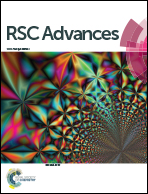Effect of length on the transport and magnetic properties of diradical substituted molecular wires†
Abstract
Extended π-conjugated molecules are known to have interesting applications as conducting nanowires, memory devices, and diodes. In the present work, we investigate the effect of the length of unsaturated organic molecular wires and radical substituted wires on the conduction properties of hybrid devices. At the same time, we also study the effect of the length of unsaturated radical substituted organic molecular wires on the magnetic properties. It was found that the value of magnetic exchange coupling constant (J) depends on the distance between spin centers. In order to measure the transmission characteristics of these conjugated molecular wires, we have designed a molecular bridge structure where the phenyl based molecular system containing conjugated multiple bonds of varying length is used as a bridging fragment between two semi-infinitely widened Au9 fcc clusters along the Au(111) direction. A state of the art non-equilibrium Green's function (NEGF) method coupled with density functional theory (DFT) based approach has been applied on this two-probe molecular bridge system to understand its electrical transport characteristics. It was observed that the molecular wires with smaller length show higher transmission. The transmission spectra of the ferromagnetically coupled diradical based molecular wires show similar behavior to those of the wires without any substitution. Hence, there is no effect of radical substitution on transport properties for ferromagnetically coupled diradical based molecular wires, whereas for antiferromagnetically coupled systems, the scenario is different.



 Please wait while we load your content...
Please wait while we load your content...